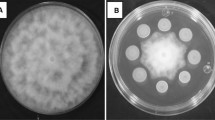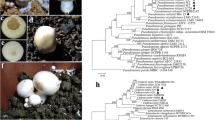Abstract
A red pigment produced by a Mexican isolate of Cercospora piaropi (waterhyacinth pathogen) has been isolated and identified as cercosporin. The kinetic of cercosporin production in culture media during dark/light regimes was evaluated. When C. piaropi was cultivated in continuous light and potato dextrose broth culture, a maximum of cercosporin production was observed (72.59 mg/l). Despite other reports, C piaropi Mexican isolate produce cercosporin in dark conditions (25.70 mg/l). The results suggest that production of cercosporin in C. piaropi-waterhyacinth pathogenesis is an important factor to take into account in biocontrol strategies.



Similar content being viewed by others
References
Martyn RD. Waterhyacinth decline in Texas caused by Cercospora piaropi. J Aquat Plant Manag. 1985;23:29–32.
Charudattan R, Linda SB, Kluepfel M, Osman YA. Biocontrol efficacy of Cercospora rodmanii on waterhyacinth. Phytopathology. 1985;75:1263–9.
Martínez JM, Gómez-Balandra MA. Integrated control of waterhyacinth in México by using insects and plant pathogens. Crop Prot. 2007;26:1234–8.
Fajola AO. Cercosporin a phytotoxin from Cercospora species. Physiol Plant Pathol. 1978;13:157–64.
Daub ME. Cercosporin, a photosensitizer toxin form Cercospora species. Phytopatology. 1982;72:370–4.
Kuyama S, Tamura T. Cercosporin. A pigment of Cercospora kikuchii Matsumoto et Tamoyasu. I. Cultivation of fungus, isolation and purification of pigment. J Am Chem Soc. 1957;79:5725–6.
Lousberg R, Chu J, Weiss W, Salmink CA, Arnone A, Merlini L, Nasini G. The structure of cercosporin, a naturally occurring quinone. Chem Commun. 1971;71:1463–4.
Ehrenshaft M, Upchurch RG. Isolation of light-enhanced cDNAs of Cercospora kikucchii. Appl Environ Microbiol. 1991;57(9):2671–6.
Jenns AE, Daube ME, Upchurch RG. Regulation of cercosporin accumulation in culture media and temperature manipulation. Phytopathology. 1989;79:213–9.
Daub ME, Herrero S, Kuang-Ren C. Photoactivated perylenequinone toxins in fungal pathogenesis of plants. FEMS Microbiol Lett. 2005;252:197–206.
Foote CS. Photosensitized oxidation and single oxygen: consequences in biological system. In: Pryor WA, editor. Free radicals in biology, vol. II. New York: Academic Press; 1976. p. 85–133.
Daub ME. Peroxidation of tobacco membrane lipids by the photosensitizing toxin, cercosporin. Plant Physiol. 1982;69:1361–4.
Daub ME, Briggs SP. Changes in tobacco cell membrane composition and structure caused by cercosporin. Plant Physiol. 1983;71:763–6.
Tessmann DJ, Charudattan R, Kistler HC, Rosskopf EN. A molecular characterization of Cercospora species pathogenic to waterhyacinth, emendation of C. piaropi. Mycologia. 2001;93(2):323–34.
Martínez-Jiménez M, Charudattan R. Survey of evaluation of Mexican native fungi for potential biocontrol of waterhyacinth. J Aquat Plant Manag. 1998;36:145–8.
Dhingra O, Sinclair JB. Basic plant pathology methods. 2nd ed. Boca Raton: CRC Press; 1994. p. 434.
Trigos Á, Castellanos-Onorio O, Salinas A, Yáñez-Morales MJ. Ergosterol from Phytophthora drechsleri, a unusual metabolite of a member of this genus. Mycopathologia. 2005;159(3):469–71.
Trigos Á, Reyna S, Matamoros B. Macrophominol, a new diketopiperazine from cultures of Macrophomina phaseolina. Phytochemistry. 1995;40(6):1697.
Mumma RO, Lukezic FL, Kelly MG. Cercosporin from Cercospora hayii. Phytochemistry. 1973;12:917–22.
Daub ME, Hangarter RP. Light-induced production of singlet oxygen and superoxide by the fungal toxin cercosporin. Plant Physiol. 1983;73:855–7.
Upchurch RG, Walker DC, Rollins JA, Ehrenshaft M, Daub ME. Mutants of Cercospora kikuchii altered in cercosporin synthesis and pathogenicity. Appl Environ Microbiol. 1991;57(10):2940–5.
Daub ME, Ehrenshaft M. The photoactivated Cercospora toxin cercosporin: contribution to plant disease and fundamental biology. Annu Rev Phytopathol. 2000;38:461–90.
Calpouzos L, Stalknech GF. Symptoms of Cercospora leaf spot of sugar beets influenced by light intensity. Phytopathology. 1967;57:799–800.
Almeida AMR, Piuga FF, Marin SRR, Binneck E, Sartori F, Costamilan LM, et al. Pathogenicity, molecular characterization, and cercosporin content of Brazilian isolates of Cercospora kikuchii. Fitopatol Bras. 2005;30:594–602.
Daub ME, Ehrenshaft M. The photoactivated Cercospora toxin cercosporin: contributions to plant disease and fundamental biology. Annu Rev Phytopathol. 2000;38:437–66.
Acknowledgments
This work was financed by CONACyT México (grant SAGARPA-2002-C01-278). We thank Gabriel Arteaga for technical assistance. RMN spectral data were provided by Unidad de Servicios de Apoyo de Resolución Analítica, Universidad Veracruzana, México.
Author information
Authors and Affiliations
Corresponding author
Rights and permissions
About this article
Cite this article
Martínez Jiménez, M., Miranda Bahena, S., Espinoza, C. et al. Isolation, Characterization, and Production of Red Pigment from Cercospora piaropi a Biocontrol Agent for Waterhyacinth. Mycopathologia 169, 309–314 (2010). https://doi.org/10.1007/s11046-009-9257-x
Received:
Accepted:
Published:
Issue Date:
DOI: https://doi.org/10.1007/s11046-009-9257-x




